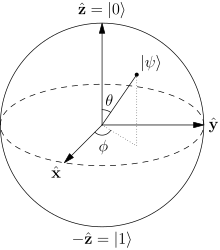Magic state distillation
Magic state distillation is a process that takes in multiple noisy quantum states and outputs a smaller number of more reliable quantum states. It is considered by many experts[1] to be one of the leading proposals for achieving fault tolerant quantum computation. Magic state distillation has also been used to argue [2] that quantum contextuality may be the "magic ingredient" responsible for the power of quantum computers.[3] Magic state distillation was first proposed by Sergey Bravyi and Alexei Kitaev [4] in 2005. A related proposal was given by Emanuel Knill in 2005.[5]
Thanks to the Gottesman–Knill theorem, it is known that some quantum operations (operations in the Clifford algebra) can be perfectly simulated in polynomial time on a probabilistic classical computer. In order to achieve universal quantum computation, a quantum computer must be able to perform operations outside this set. Magic state distillation achieves this, in principle, by concentrating the usefulness of imperfect resources, represented by mixed states, into states that are conducive for performing operations that are difficult to simulate classically.
A variety of magic state distillation routines[6][7] with various advantages have been proposed since Bravyi and Kitaev's original protocol was published.
Stabilizer formalism
The Clifford group consists of a set of -qubit operations generated by the gates {H, S, CNOT} (where H is Hadamard and S is ) called Clifford gates. The Clifford group generates stabilizer states which can be efficiently simulated classically, as shown by the Gottesman–Knill theorem. This set of gates with a non-Clifford operation is universal for quantum computation.[4]
Magic states
Magic states are purified from copies of a mixed state .[6] These states are typically provided via an ancilla to the circuit. The magic state (for the gate) is where . By combining (copies of) magic states with Clifford gates, can be used to make a non-Clifford gate.[4] Since Clifford gates combined with a non-Clifford gate are universal for quantum computation, magic states combined with Clifford gates are also universal.
Purification algorithm for distilling
The first magic state distillation algorithm; invented by Sergey Bravyi and Alexei Kitaev is a follows.[4]
- Input: Prepare 5 imperfect states.
- Output: An almost pure state having a small error probability.
- repeat
- Apply the decoding operation of the Five qubit error correcting code and measure the syndrome.
- If the measured syndrome is , the distillation attempt is successful.
- else Get rid of the resulting state and restart the algorithm.
- until The states have been distilled to the desired purity.
References
- Campbell, Earl T.; Terhal, Barbara M.; Vuillot, Christophe (14 September 2017). "Roads towards fault-tolerant universal quantum computation" (PDF). Nature. 549 (7671): 172–179. doi:10.1038/nature23460. PMID 28905902.
- Howard, Mark; Wallman, Joel; Veitch, Victor; Emerson, Joseph (11 June 2014). "Contextuality supplies the 'magic' for quantum computation". Nature. 510 (7505): 351–355. arXiv:1401.4174. doi:10.1038/nature13460. PMID 24919152.
- Bartlett, Stephen D. (11 June 2014). "Powered by magic". Nature. 510 (7505): 345–347. doi:10.1038/nature13504. PMID 24919151.
- Bravyi, Sergey; Kitaev, Alexei (2005). "Universal quantum computation with ideal Clifford gates and noisy ancillas". Physical Review A. 71 (2): 022316. arXiv:quant-ph/0403025. doi:10.1103/PhysRevA.71.022316.
- Knill, E. (March 2005). "Quantum computing with realistically noisy devices". Nature. 434 (7029): 39–44. arXiv:quant-ph/0410199. doi:10.1038/nature03350. PMID 15744292.
- Bravyi, Sergey; Haah, Jeongwan (2012). "Magic state distillation with low overhead". Physical Review A. 86 (5): 052329. arXiv:1209.2426. doi:10.1103/PhysRevA.86.052329.
- Meier, Adam; Eastin, Bryan; Knill, Emanuel (2013). "Magic-state distillation with the four-qubit code". Quantum Information & Computation. 13 (3–4): 195–209. arXiv:1204.4221.
